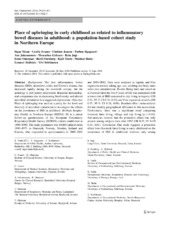| dc.contributor.author | Timm, Signe | en_US |
| dc.contributor.author | Svanes, Cecilie | en_US |
| dc.contributor.author | Janson, Christer | en_US |
| dc.contributor.author | Sigsgaard, Torben | en_US |
| dc.contributor.author | Johannessen, Ane | en_US |
| dc.contributor.author | Gíslason, Thorarinn | en_US |
| dc.contributor.author | Jõgi, Rain | en_US |
| dc.contributor.author | Omenaas, Ernst | en_US |
| dc.contributor.author | Forsberg, Bertil | en_US |
| dc.contributor.author | Torén, Kjell | en_US |
| dc.contributor.author | Holm, Mathias | en_US |
| dc.contributor.author | Bråbäck, Lennart | en_US |
| dc.contributor.author | Schlünssen, Vivi | en_US |
| dc.date.accessioned | 2015-03-23T13:54:46Z | |
| dc.date.available | 2015-03-23T13:54:46Z | |
| dc.date.issued | 2014-06 | eng |
| dc.identifier.issn | 0393-2990 | |
| dc.identifier.uri | https://hdl.handle.net/1956/9618 | |
| dc.description.abstract | Background The two inflammatory bowel diseases (IBD), ulcerative colitis and Crohn's disease, has increased rapidly during the twentieth century, but the aetiology is still poorly understood. Impaired immunological competence due to decreasing biodiversity and altered microbial stimulation is a suggested explanation. Objective Place of upbringing was used as a proxy for the level and diversity of microbial stimulation to investigate the effects on the prevalence of IBD in adulthood. Methods Respiratory Health in Northern Europe (RHINE) III is a postal follow-up questionnaire of the European Community Respiratory Health Survey (ECRHS) cohorts established in 1989–1992. The study population was 10,864 subjects born 1945–1971 in Denmark, Norway, Sweden, Iceland and Estonia, who responded to questionnaires in 2000–2002 and 2010–2012. Data were analysed in logistic and Cox regression models taking age, sex, smoking and body mass index into consideration. Results Being born and raised on a livestock farm the first 5 years of life was associated with a lower risk of IBD compared to city living in logistic (OR 0.54, 95 % CI 0.31; 0.94) and Cox regression models (HR 0.55, 95 % CI 0.31; 0.98). Random-effect meta-analysis did not identify geographical difference in this association. Furthermore, there was a significant trend comparing livestock farm living, village and city living (p < 0.01). Sub-analyses showed that the protective effect was only present among subjects born after 1952 (OR 0.25, 95 % CI 0.11; 0.61). Conclusion This study suggests a protective effect from livestock farm living in early childhood on the occurrence of IBD in adulthood, however only among subjects born after 1952. We speculate that lower microbial diversity is an explanation for the findings. | en_US |
| dc.language.iso | eng | eng |
| dc.publisher | Springer | eng |
| dc.rights | Attribution CC BY | eng |
| dc.rights.uri | http://creativecommons.org/licenses/by/4.0 | eng |
| dc.subject | Inflammatory bowel disease | eng |
| dc.subject | Ulcerative colitis | eng |
| dc.subject | Crohn’s disease | eng |
| dc.subject | Microbial exposure | eng |
| dc.subject | Rural/urban environments | eng |
| dc.subject | Hygiene hypothesis | eng |
| dc.title | Place of upbringing in early childhood as related to inflammatory bowel diseases in adulthood: A population-based cohort study in Northern Europe | en_US |
| dc.type | Peer reviewed | |
| dc.type | Journal article | |
| dc.date.updated | 2015-03-05T07:54:08Z | en_US |
| dc.description.version | publishedVersion | en_US |
| dc.rights.holder | Copyright 2014 The Authors | |
| dc.identifier.doi | https://doi.org/10.1007/s10654-014-9922-3 | |
| dc.identifier.cristin | 1162034 | |
| dc.source.journal | European Journal of Epidemiology | |
| dc.source.40 | 29 | |
| dc.source.14 | 6 | |
| dc.source.pagenumber | 429-437 | |
| dc.subject.nsi | VDP::Medical sciences: 700::Health sciences: 800::Epidemiology, medical and dental statistics: 803 | eng |
| dc.subject.nsi | VDP::Medisinske fag: 700::Helsefag: 800::Epidemiologi medisinsk og odontologisk statistikk: 803 | nob |

